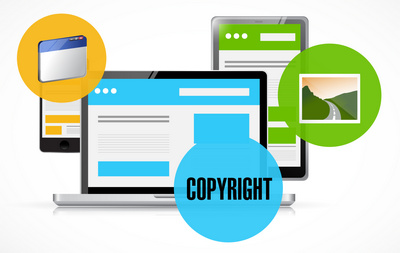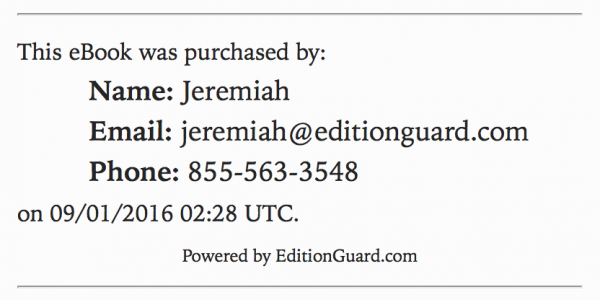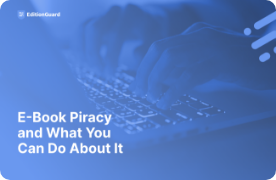
The piracy of digital content like music, movies, and books is a well-known source of concern for artists and publishers alike.
A file can be copied and redistributed with virtually no recourse for those affected by the theft. And one of the biggest concerns in this space is the fact that technology enabling the theft of digital files is constantly evolving to circumvent the technology that protects ownership.

(Source:
stock.adobe.com)
That’s why it is extremely important for anyone involved in the digital publishing supply chain to remain aware of the most effective methods of protecting their most valuable assets.
In today’s post, we are going to take an in-depth look at the various mechanisms that limit the threat piracy poses to publishers and artists alike.
Implement Copyright
While this is not a technical mechanism and offers no functionality that physically prevents access or duplication of content, it’s presence is often enough to deter the more casual pirate. It also forms the foundation for any legal recourse the owner of the content may be able to seek should the perpetrator be caught.
Copyrighting a book is extremely simple, with the majority of the protection it offers the creator being in place automatically from the day that it is finished. However, to enjoy the full spectrum of protection that implementing a copyright can offer a publisher based in the United States, it becomes necessary to
register your copyright.

(Source:
stock.adobe.com)
The latter process is relatively pain-free with the main benefits of doing it being:
- It’s an additional deterrent for a pirate who may already be concerned with the legality of their actions.
- You are able to sue the perpetrator for copyright infringement.
- Under certain conditions, you are entitled to statutory damages in addition to the recovery of lost income and legal fees.
Store Your Products Securely
When you store your digital assets on a web server, it is vulnerable to web crawlers that scour the internet looking for files with specific extensions such as .epub, .mp4, and .pdf.
When a crawler finds these files, they will be accessible via search engine or, in some cases, scraped from your server by pirates looking for any valuable file to include in their inventory of stolen content.
The most effective ways of preventing this are:
Use Content Recognition Tools
For artists and publishers in the visual arts space, an option to prevent the appropriation of your content is to regularly perform a “reverse image search” with online tools like
Tineye or even Google’s
image search.
By regularly uploading one of your files into the tool’s search interface, you are able to find all the websites that have published the image online.
While this may be a somewhat reactive approach and doesn’t offer functionality that prevents imagery from being used, it does offer some form of recourse and if copyright exists on the image, legal recourse is always a possibility.
For publishers of written content,
Copyscape offers a similar feature.
Publish Your Content on Streaming Services
This method is most appropriate for artists and publishers in the audio industry. A recent study published by
Business Insider indicated that that piracy in Norway decreased from 80% to 4% in the space of five years due to content being available on more affordable subscription services like
Bandcamp,
Spotify and
Google Music.
Giving your audience the option to access your content by using a subscription service, you are contributing to eliminating one off the main reasons for piracy:
the prohibitive cost of media.
Another reason for the success of this approach is that users can’t access the source file of content that is streamed, making illegal duplication of the file impossible. If this is your sole method of “selling” content, there will never be a reason for a customer to have access to the physical file on their computer or device.
Security is a major concern for majority of streaming services and most of them can afford to invest in the latest and greatest technology to keep their archive of digital content safe from hackers.
Make Your E-Books Accessible Via the Cloud
This is the e-book equivalent of the above solution for audio content. When your book is not downloaded to the buyer’s laptop or mobile device, there is no way for them to access the source file to make a duplicate to distribute.
The alternative is to have the customer read the e-book while they are logged into a secure platform where the book can be accessed and read.
This is dependent on the user needing to be online while reading their book, but this is no longer the concern it was a couple of years ago. Some of the most popular media platforms, like Netflix, require customers to be online while consuming their content and most internet-savvy users have become quite comfortable with this concept.

(Source:
stock.adobe.com)
This approach to privacy prevention is one of the primary functional benefits EditionGuard offers publishers — a secure and always-available online environment where their customers can access the books they bought from them.
Create Accountability Through Social DRM
An emerging method of preventing piracy is to embed the social media profile of the person who “owns” the product as a watermark into the content. When the content, usually an e-book, finds its way onto torrent sites, the source of the illegal distribution can be identified.
This level of transparency is an extremely effective way of incentivizing the owners of digital media not to duplicate and distribute the content that they paid for, since their personal contact details will be visible to everyone who downloaded the file (or invisibly detectable by authorities).

This is a protection mechanism that EditionGuard offers publishers who subscribe to our services. Read more about EditionGuard’s Social DRM offering by
clicking here.
Prevent Copy-and-Paste
Sometimes simply having the file’s content visible on a laptop or mobile device is enough to duplicate it, even if the source file is inaccessible. One way that content thieves achieve this is by simply selecting all of the text in a PDF or epub document, copying it, and pasting it into a new blank document which can be renamed and repackaged into a facsimile of the original work.
Fortunately, EditionGuard offers a solution to this piracy technique. When uploading a book into your online inventory using our interface, you have the option of preventing this standard function when the user has the file open on their device.
Implement an Expiration Date
EditionGuard’s rights management system offers publishers the option to have books “expire” after a predefined period of time. This turns the publisher’s inventory of books into a virtual library, which will appeal to certain users and also significantly limit the risk of illegal duplication and distribution.
Essentially, after a certain period of time has expired, the user’s copy the their e-book is “returned” and they no longer have access to it.
This setting can be applied wither by capturing a specific future date, or a number of days that must elapse, before the expiration is triggered.
In Closing
Piracy is an enormous industry that robs content creators of billions of Dollars every year, and the people creating the tech that enables theft are highly motivated to keep eliminating the safeguards publishers put in place to protect their income.
When choosing methods for protecting yourself from piracy, it is essential that you partner with a DRM solutions provider doing all they can to stay ahead of the competition.
EditionGuard offers independent publishers the option to partner with the very best: Adobe DRM. All the benefits offered by the industry leaders in the digital rights space can be yours for a fraction of the cost if you sign up as an EditionGuard customer.
Our software is extremely easy to integrate into your online bookstore and our prices are very affordable.
Click here for a free trial of our remarkable solutions.
 The piracy of digital content like music, movies, and books is a well-known source of concern for artists and publishers alike.
A file can be copied and redistributed with virtually no recourse for those affected by the theft. And one of the biggest concerns in this space is the fact that technology enabling the theft of digital files is constantly evolving to circumvent the technology that protects ownership.
The piracy of digital content like music, movies, and books is a well-known source of concern for artists and publishers alike.
A file can be copied and redistributed with virtually no recourse for those affected by the theft. And one of the biggest concerns in this space is the fact that technology enabling the theft of digital files is constantly evolving to circumvent the technology that protects ownership.
 (Source: stock.adobe.com)
That’s why it is extremely important for anyone involved in the digital publishing supply chain to remain aware of the most effective methods of protecting their most valuable assets.
In today’s post, we are going to take an in-depth look at the various mechanisms that limit the threat piracy poses to publishers and artists alike.
(Source: stock.adobe.com)
That’s why it is extremely important for anyone involved in the digital publishing supply chain to remain aware of the most effective methods of protecting their most valuable assets.
In today’s post, we are going to take an in-depth look at the various mechanisms that limit the threat piracy poses to publishers and artists alike.
 (Source: stock.adobe.com)
The latter process is relatively pain-free with the main benefits of doing it being:
(Source: stock.adobe.com)
The latter process is relatively pain-free with the main benefits of doing it being:
 (Source: stock.adobe.com)
This approach to privacy prevention is one of the primary functional benefits EditionGuard offers publishers — a secure and always-available online environment where their customers can access the books they bought from them.
(Source: stock.adobe.com)
This approach to privacy prevention is one of the primary functional benefits EditionGuard offers publishers — a secure and always-available online environment where their customers can access the books they bought from them.
 This is a protection mechanism that EditionGuard offers publishers who subscribe to our services. Read more about EditionGuard’s Social DRM offering by clicking here.
This is a protection mechanism that EditionGuard offers publishers who subscribe to our services. Read more about EditionGuard’s Social DRM offering by clicking here.


